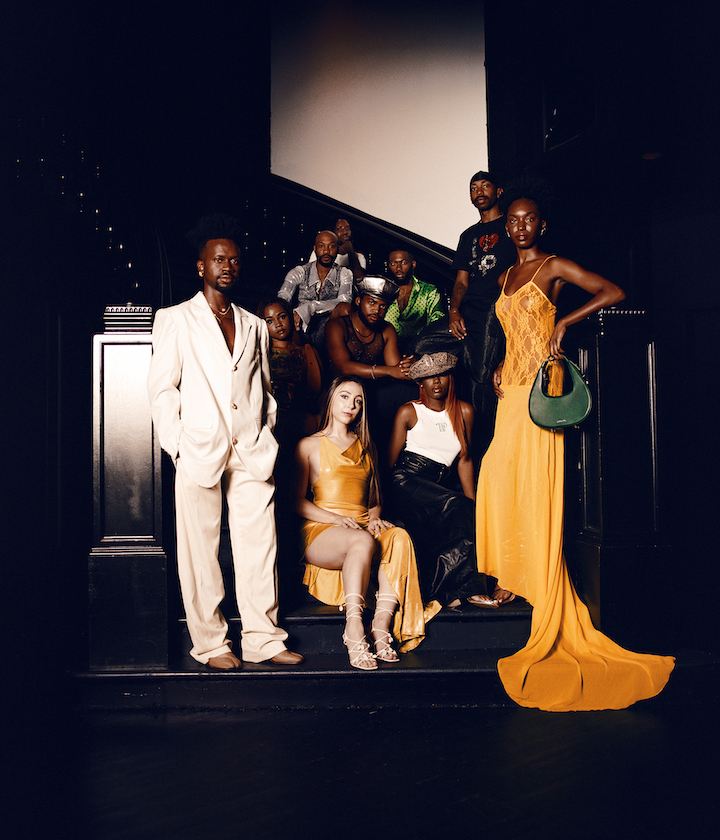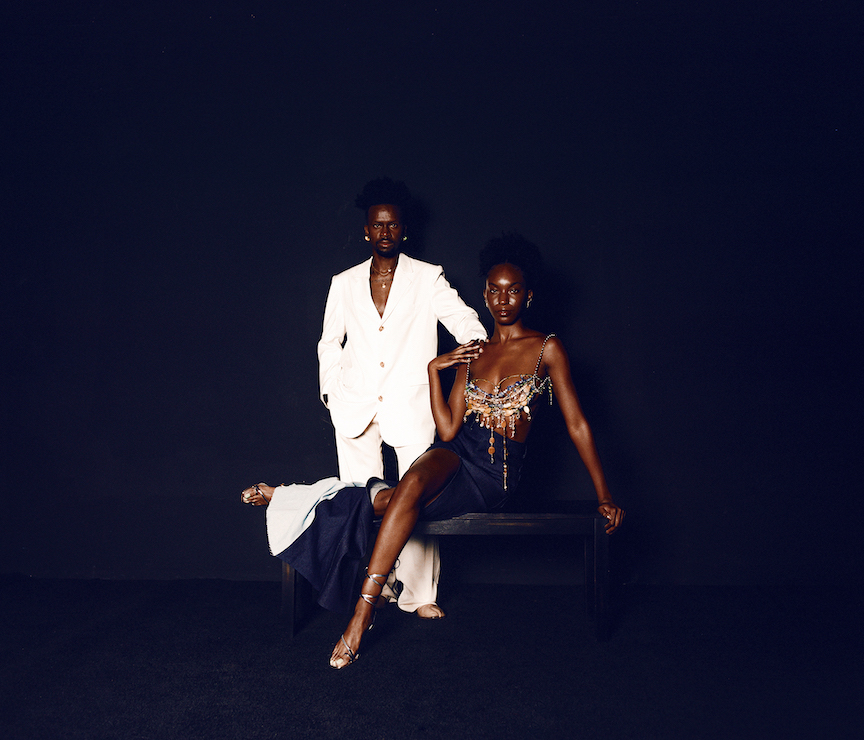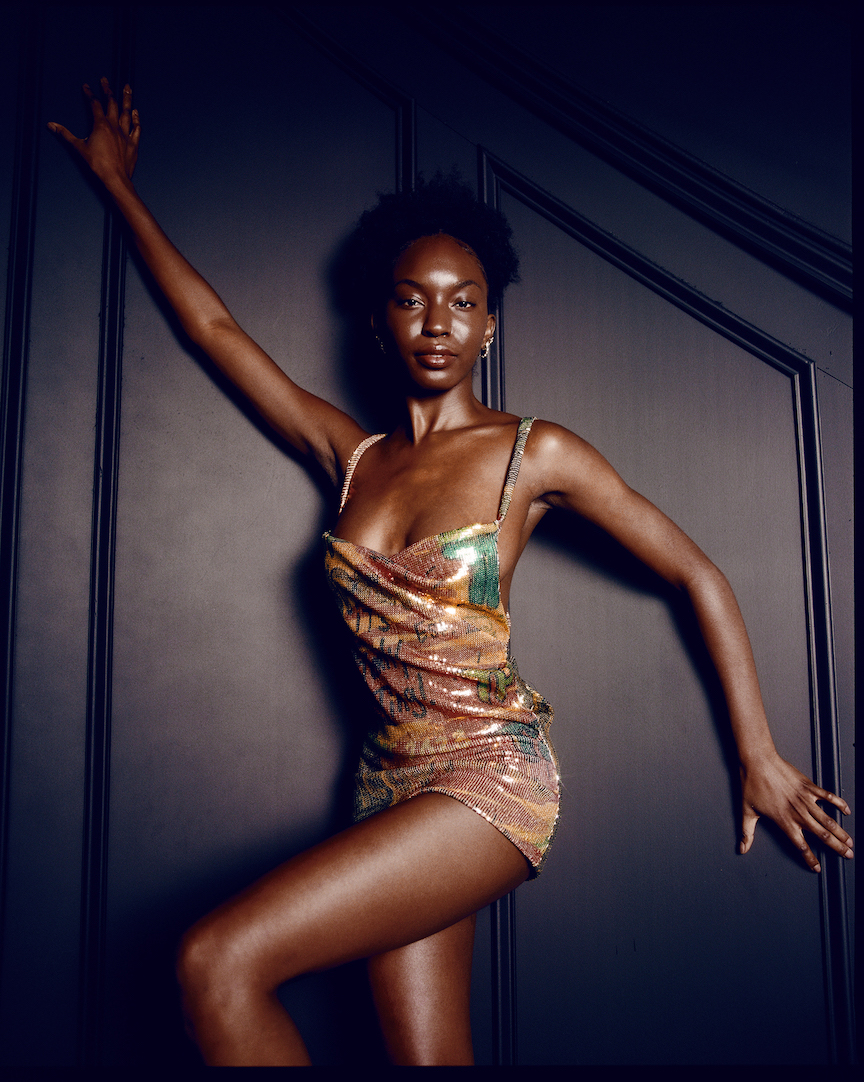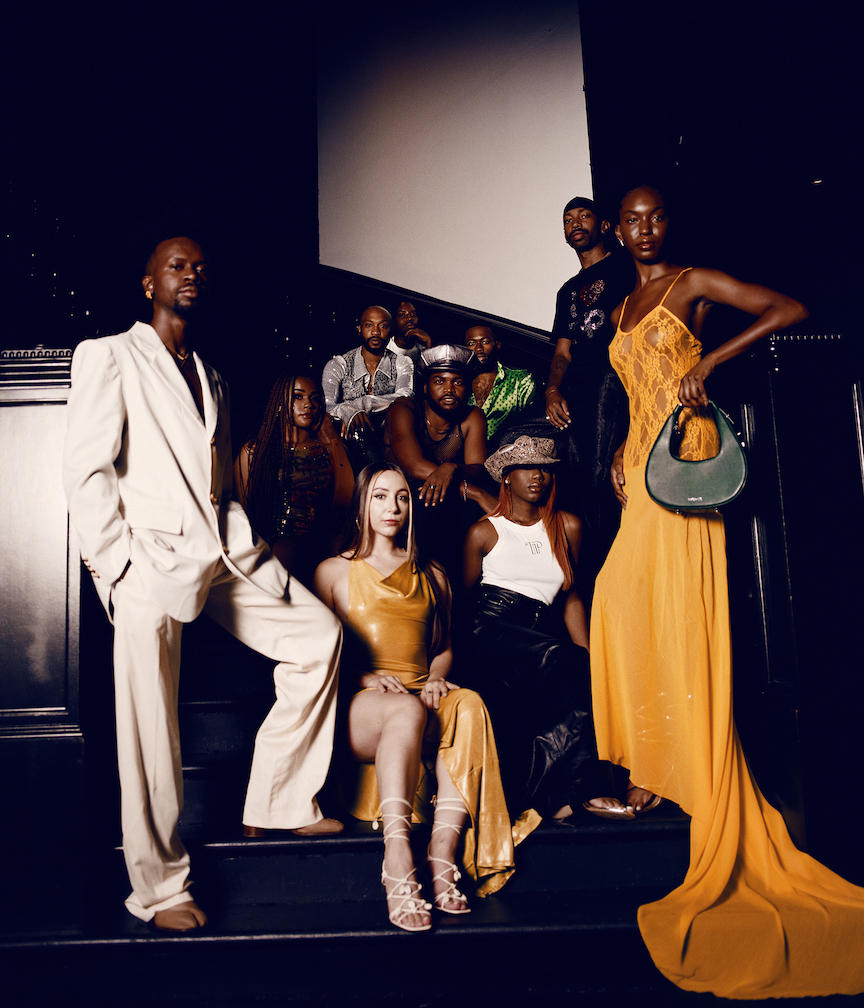New Guards: Theophilio
From embracing real community to the realities of the industry, designer Edvin Thompson gives his perspective on the new ways to do fashion

This feature appears in V139, Supermodel, Superhero issue, now available for purchase.
There are island motifs throughout the ready-to-wear and accessories of Theophilio that are clear as day, an essence that is deep-rooted in the experiences of brand founder and creative director, Edvin Thompson. Born in Kingston, Jamaica—eventually uprooting to New Jersey, Atlanta, and finally, Brooklyn—the designer uses fashion as a language to manifest his innermost thoughts to the world.

There’s a poetic justice when Thompson speaks of the ups and downs experienced in the industry—he is on the up and up as the 2021 CFDA Emerging Designer of the Year and a now New York Fashion Week regular. “People are looking at the brand or at me like it’s an overnight success,” says Thompson. “I’m not thinking about these people [or] about the setbacks because I’m Black and young. If I see it as a hurdle, I will jump right over it. I don’t let it stop me.”
Authenticity, an overused and diluted word, is what many say they strive for—but Thompson says it with gumption and honesty. He champions those who work alongside him, citing fellow New York designers like Christopher John Rogers and Brandon Blackwood as true confidants and inspirations. The New York fashion scene has come a long way, but Thompson sees the potential of what it could really be—a space to create and thrive, a table with endless seats.
Below, the designer talks with V about the plight of fashion in the internet age, (real) community, and the intangibles that make Theophilio so special.

V MAGAZINE: In your most recent show, how did you want to challenge yourself when it came to your design process and showing your voice visually? What were your inspirations this season?
EDVIN THOMPSON: I wanted to challenge myself this season by extending or playing with different silhouettes, and I wanted to challenge myself with tailoring this season. I think it’s a bit of a new arena for me to step into. I personally think it turned out great, and I’m seeing men’s and women’s blazers on the runway and everything in between. I thought it was very purposeful. I think there were so many things that weren’t on the runway, but that were created within the collection. I’m really excited to extend that through the press, in-house editorials, customs, and some collaborations coming up.
Going into this process, I wanted to share my perspective on fashion in the early 2000s. It was very bold, it was very colorful, but at the same time, it was very sophisticated. It was very serious. I thought it was so important for me to share that motif in a sense because I think people look at Theophilio as this colorful, vibrant Jamaican brand. I really want to see the pieces on the runway, and I want to share the pieces on the runway for them to be in a space where they can be perceived without all the glitz, but more [through] the energy of the models and the clothing.
V: You mentioned exploring Y2K aesthetics through an immigrant experience. Can you explain that viewpoint? How has the Y2K era inspired you through that lens?
ET: When I first came to America, early on, I used fashion and art as a tool to communicate with people and understand people. Being a gay Black man in this landscape, a lot of things are very different for me. With music at the time, there were these albums that came out with Caribbean, reggae, or dancehall songs—it was a style everyone followed then [but] a lot has changed. I looked at that [Caribbean style in mainstream culture], and it made me want to create. I’d go to class, and [that style] didn’t seem generally supported. It didn’t seem like a genuine space unless it was selling tickets or selling an experience. I’m saying this because there are pockets of Jamaica all over. We bring so much to pop culture, and I think it should have a realistic approach.
V: Your Jamaican heritage has influenced so much of your design process and your brand’s ethos visually. Are there any non-visuals within your culture that influenced your work?
ET: Music and food. There is a visual aspect, but I would also say there’s a spiritual aspect. My heritage is very accepting of people, even with me being gay and Jamaican. Things have grown over the years because of how resilient the people are. We want to create a safe space to have a genuine dialogue. But again, I’m doing similar [things] as this generation of Jamaicans from the Caribbean diaspora. So many of us are doing different artistic mediums and I love that. People are waving their flag versus waving the American flag first—even on American soil. With the Met Gala being ‘America: A Lexicon of Fashion,’ what is American fashion? What does that look like? It’s a loaded question because there are so many different pockets of communities in America, and it’s so vital. When you look at American culture and American fashion, it’s just a plethora of things. I think accepting that but not using these different voices is a tool to oppress in a way. I know this may seem loaded, but I think that the non-visible aspect really inspires me. The nuance of people’s perception of being like, ‘Oh, I’ve never seen a Jamaican designer before.’
People have gotten acclimated to not being able to see these people in these spaces because no one has ever done it. This is why I talk about visibility and the impact of seeing yourself. If you want to be a doctor, and you see somebody that looks like you as a doctor, you’re like, ‘I can do that.’ There’s this subconscious freedom. That’s what freedom is. I don’t think people are free in their minds in that sense. It’s about the non-tangible or non-visible that inspires me. I just want to have a wider conversation that really celebrates yourself and visibility. It may be cliche, but it’s so important to be able to see yourself, and that goes for everyone/
V: What are the other influences you’ve looked to of late?
ET: I’ve been really trying to tap into reading or going through visual books because I’m into real-time inspirations, but I also like how my day-to-day is. Things like walking past someone on the train, their hair being a certain type of way, a really cool, cut jacket. For the first time, I documented the [design] process. I think things come to me frequently and it may give me sensory overload, so I try to document things and ideas for a collection.
V: And what do you think has been the biggest challenge from being an up-and-coming designer to an established label?
ET: I think funding. Finance is a pivotal part of being a brand, and especially by myself, everything is made in New York. It is extremely expensive. At any level, your company will be in that struggle, so it’s just finding that proper footing. Capital is so important for any business, but I never really started with any capital. I’ve literally put everything into Theophilio. There has always been this ultimate struggle for proper cash flow. It’s a whole process. It even adds to having design integrity. You want to create amazing products, sustainable products and I think that goes hand in hand as well. You have to look at the market; there’s just so many variables to solidify yourself in this business.

V: When you first started the brand, what was the goal? And how has the brand grown since those goals?
ET: I’ve always wanted to portray myself as an honest artist. We’re talking about where I’m from—I’m not really into optics. We’re selling the story because we’re living the story that we’re telling. As an artist, you should be very honest about the work you’re doing. Before COVID, even during the pandemic, folks were just subscribing to the stories of many businesses rather than the products. I think that has subconsciously been a part of my ideology [connecting the consumer to the product and brand ethos] since I started the brand. It’s a continuous thing, and I’m really proud of myself that I’ve stuck to that. This is what I believe in, and this is what I’ve set out to do.
V: And pivoting to the CFDA, you obviously won the American Emerging Designer award last year. What have the past months been, both personally and as a brand? Where do you see the brand going in the next ten years?
ET: Ten years, that’s big time.
V: How about five years?
ET: I really want to have a seamless direct to consumer process. That’s one of our major goals within the next five years. That’s going to be such an amazing thing, having that whole, see now, by now system. I think it’s so important for us, especially putting up goods and having our customers wait so long for them. I don’t agree with that. It’s just a system that fashion has acclimated to, and I want to be a part of the small set of designers that are changing that around. I also think social media has really changed, so I want to focus more on that. I think it’s important for brands to have a running online store, which would be amazing within the next five years.
Five years is short, but ten years is such a big growth; crazy things can happen within five years. Within the last two years, a shitload of stuff has happened. Within the next year or two, having a seamless process for our supporters and our consumers will be amazing. Then five years from now, having a cool little boutique, an in-person experience, would be amazing. Ten years from now, we’ll just be in the Paris shows, and the London shows. Creating very impactful experiences. I think the brand gets bigger, the experiences get bigger and more impactful, and our reach as well.
V: Who’s someone that you would really want to maybe make something custom for?
ET: I would love to dress Michelle Obama. Definitely stepping into that lane. Michelle Obama in Theophilio. That just sounds so chic.
V: Yes, it does. I also wanted to ask about navigating the industry as a Black designer. How has your identity informed your creative sensibilities? Also, can you describe your experiences navigating the industry, and any experiences, good or bad, that you may have had?
ET: I think the experience that I probably have in the industry passively may have been kind of racial—for obvious reasons. I also think people are looking at the brand or at me like it’s an overnight success. I realized later when I’m in the process, I’m really in the process. I’m not thinking about these people, about the setbacks because I’m black and young, or whatever the case may be. Those are just optics. I mean, they’re real. They’re real, but for some reason, I’m very tunnel vision. I slow down and analyze those optics wherever I’m having a general conversation. If I see it as a hurdle, I will jump right over it. I don’t let it stop me. There have been moments of passive-aggressive racism, but they were never defining moments.
V: That makes sense. I feel like that’s a better experience than most.
ET: It’s a privilege. I think it’s a privilege for me to be a man that is a fashion designer. I think that’s a privilege also. The optics are definitely a little different. I think, in this age of sensationalism, everything is sensationalized, even on social media. Everyone wants to be the star; everyone wants to be the main character. Literally, everyone wants to be the main character, you can have people who work back of house, and they want you to know they work back of house. It’s very odd to me, but I think that this is a process for everyone. This is how I generally view everything, everything is sensationalized, and I think it’s caused a lot more damage than good, in my opinion.
V: You’re an independent label, and independent labels have really made their presence known over the past few seasons. They’ve definitely taken over the spotlight from very established fashion houses. How would you define the New York fashion scene in today’s context?
ET: It’s not even in real-time. I’m looking at the internet; it’s a different world. I see how people kind of just live on the internet, and when they go outside, they can literally just be wearing sweatsuits. You don’t even know that person. I’m like, ‘the internet’s fab, social media is fab, all that is fab,’ but I’m also going to parties. I’m getting fucked up and meeting amazing people and having great conversations, but doing the same thing online as well. It puts things into perspective. I’ll just stay talking about the fashion scene in New York because I do go out, and I do meet amazing creatives that champion me, and I champion them as well. I was like, Oh my God, I’ve been meaning to meet these people, and I love having those moments. I think it is this thing about living in New York as well. New Yorkers are so resilient. If nobody is gonna do it for us, we’ll do it for ourselves and show how we really support each other. Speaking to the past, the epidemic of monkeypox, me and my partner DeQuan going to get vaccinated and seeing actual people in the community being the ones administering these vaccines. I thought it was just so powerful. Brooklyn has the best parties. I’m finally stating it, fuck the city, Brooklyn’s where it’s at. I think that’s like the heart of New York and New York culture.
V: You have a great community and team around you and your brand. Can you just talk about the importance of fostering a community, especially in the New York fashion scene?
ET: It’s very vital. I think it certainly leads to success. It’s really expensive to build a business. If you have some sort of organic community, I think it will go a long way. I’m working with people that I’ve been working with since the beginning of the inception of Theophilio. My art director and I used to work at American Apparel together. He creates the logos and the brand decks. When we collaborate, it’s an instant thing. If we have to make a custom jacket real quick, he can literally do that in a heartbeat. We’ve grown so much. We understand each other. Even with Christian Cody, I’ve worked with Christian since I moved to New York. I’ve been in New York for eight years, and I’ve known him for almost a decade, if not more. I’ve always recognized that it’s the safest thing for me to work with people that I’m familiar with. Those people will value you, and I also can’t train folks right now. My focus would be to be a mentor, but this is all in real time. Every day, I learn something new. It’s looking at this system, which is what everyone’s used to. I know what got me here; nothing got me here but my damn self and really pushing myself. This is what I want to do because this is what I’ve been doing. I’m not gonna acclimate to the system. That’s never worked for me, and it’s not for me anyway. I’m a part of the group of artists and designers that are changing that, and I think it’s really dope.
V: When you were saying this system wasn’t really built for you. It’s really beautiful that you’ve been able to build your own system, build your own table, and make your own seat at the table. I feel like for other young designers and creatives, who look like you, who pretty much are the younger version of you, it’s important to be able to show the resilience of that too.
ET: I think that’s so important. Resilience, right? Christopher John Rogers is my friend, and Brandon Blackwood and Raul Lopez they’re my real friends. I can call them right now for anything, and they’ll be there for me. Before, European designers were sharing each other’s factories, and why are we not doing that for us? I think that’s where it starts. I just want to be the difference I talk about.

Discover More
